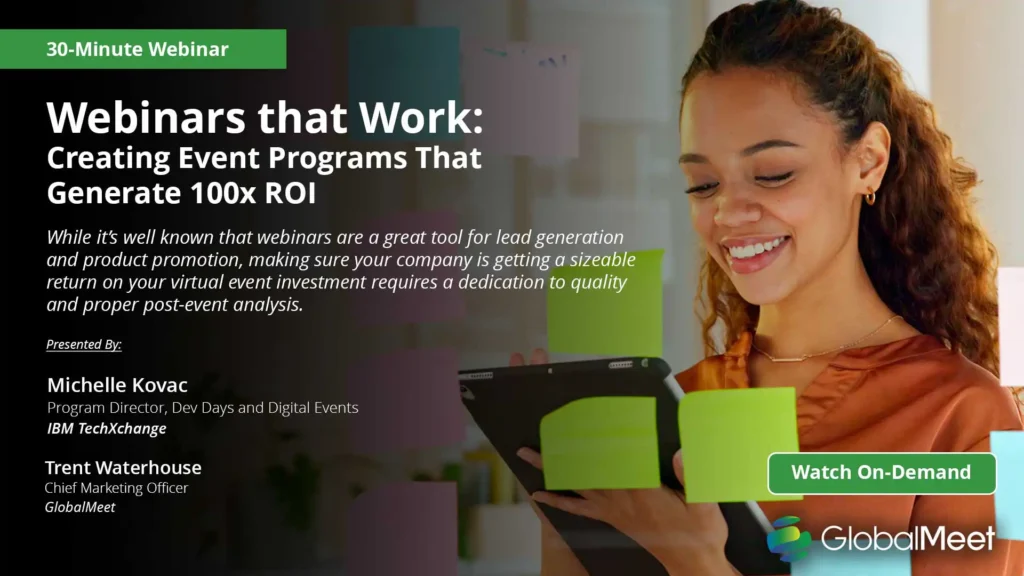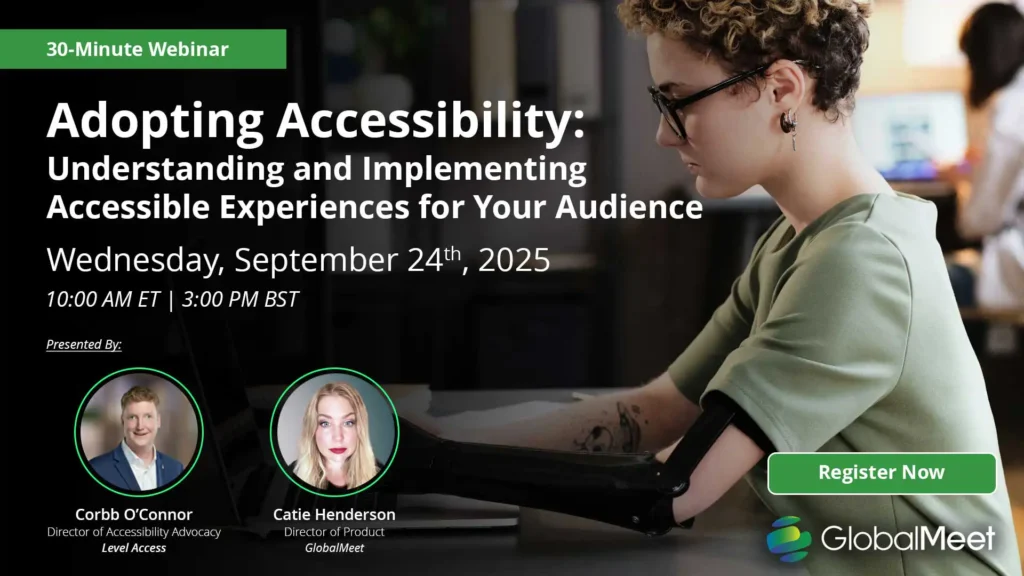
Are we Losing the Human Touch? Keeping Virtual Events Personal and Authentic
- by GlobalMeet Blog Team
- ,
As virtual events become a staple in professional calendars, their convenience and scalability have revolutionized how we connect. From webcasts and conferences to networking sessions and workshops, virtual formats enable participation across time zones and borders. Yet with this digital progress comes a growing concern: are we sacrificing human connection in the process?
In the face of improved technology and sophisticated platforms, attendees still often describe online experiences as impersonal or transactional. The challenge for organizers now is to not only deliver content, but to foster emotional resonance and authentic human connection in the virtual space.
The Risk of Digital Detachment
The primary appeal of virtual events — ease of access — can ironically also be the leading cause of attendee disengagement. Studies show that a high number of virtual event attendees are tuning in from ‘out of office’ locations such as their car, a local café, or even while multitasking between other meetings. The sense of formality, focus, and shared atmosphere that’s intrinsic to physical gatherings is harder to recreate online, and without those tangible environmental cues, digital events risk becoming passive experiences rather than immersive ones.
This detachment is compounded by the fact that many virtual events often follow a rigid format: pre-recorded sessions, one-way communication, and a lack of spontaneous interactions. While efficiency might be high, the cost of that efficiency is low emotional investment.
Why Do Some Virtual Events Feel Impersonal or Transactional?
Though it is impossible to identify one single cause for this lowered engagement, several factors may contribute to the sense of emotional distance:
- One-size-fits-all content: When attendees aren’t offered tailored content paths, sessions can feel irrelevant or generic.
- Minimal human interaction: A lack of direct engagement with speakers or peers makes it difficult to build rapport.
- Overuse of automation: While helpful for logistics, automated communications can make attendees feel like just another number.
- Lack of informal spaces: In-person events thrive on hallway chats, breakout sessions, and shared coffee breaks — moments that rarely exist in virtual formats.
Ultimately, when virtual event engagement feels like checking a box rather than participating in a shared experience, attendees are less likely to feel valued or seen.
Personalization as a Bridge
To rebuild that lost intimacy, personalization is a key tool. When attendees feel that an event has been designed with their interests, challenges, or goals in mind, the experience becomes significantly more engaging. It’s the digital equivalent of being greeted by name at a physical venue.
Some effective personalization tactics include:
- Tailored agendas: Use registration data to suggest personalized session tracks.
- Curated content paths: Recommend content based on attendee roles, interests, or past behavior.
- Personal welcome messages: Instead of generic emails, craft thoughtful welcome notes using attendees’ names and interests.
- Custom networking opportunities: Match attendees with peers or mentors for meaningful 1:1 sessions.
These small touches tell attendees, you matter. And that sense of being recognized is just part of making virtual experiences feel more human.
Prioritizing Emotional Resonance
Too often, virtual event planning is centered around logistics and metrics: attendance numbers, watch time, click-through rates. While these are valuable, they don’t capture how people feel. Emotional resonance — how an event makes someone feel — is just as critical to its success as the data that underpins it.
Incorporating human-centered design into virtual events can make a huge difference. This might include:
- Building moments of vulnerability or storytelling into sessions.
- Allowing space for attendee voices, questions, and personal input.
- Using visuals, music, and tone that evoke warmth rather than corporate sterility.
As event organizers, it’s worth asking: How do we want attendees to feel when the event ends? Inspired? Connected? Energized? Design for those emotions, not just outcomes, and watch attendee behavior develop before your eyes.
Speaker Authenticity and Tone
Speakers play a pivotal role in bridging the digital divide. While polished delivery and expertise matter, what truly captures attention in a virtual space is authenticity. Attendees want to see the real person behind the title.
Encourage speakers to:
- Be conversational when appropriate, rather than overly formal.
- Share occasional anecdotes or behind-the-scenes glimpses along with regular content.
- Engage directly with attendee questions and comments, by name wherever you can.
- Use video (rather than slides alone) to foster eye contact and presence.
In essence, human warmth trumps professional polish when it comes to virtual engagement. People remember feelings, not bullet points. A speaker who feels approachable and genuine will do more to captivate an audience than a flawlessly executed script.
Interactive Features That Feel More Human
Enterprise grade virtual event platforms now offer engagement tools like polls, Q&As, and chat. But to keep things feeling personal, these tools must be used intentionally rather than being set up and ignored.
Make use of:
- Live Engagement: Recognizing attendees by name during a session fosters inclusion and belonging.
- Virtual coffee breaks: Organize small-group breakout sessions around casual topics to mimic in-person mingling.
- Real-time feedback tools: Use reactions or polls to allow emotional responses, not just functional ones.
- Community-driven content: Let attendees vote on breakout topics or speakers they’d like to hear from in future events. Then make it happen.
The goal is to make attendees feel like participants, not passive viewers. When engagement is humanized, attendees are more likely to lean in rather than tune out.
Hybrid Models: The Best of Both Worlds
Though less common than virtual events, many planners are now turning to hybrid models to create a blend of in-person and digital experiences. Done right, these allow for the flexibility of virtual events with the depth of in-person connection.
Some hybrid best practices include:
- Offering localized watch parties or hubs for attendees who want to gather.
- Ensuring virtual attendees have equal opportunities for networking and engagement as those ‘in the room’.
- Designing content that translates well across formats (e.g., interactive workshops rather than passive lectures).
Hybrid models remind us that connection doesn’t have to be all-or-nothing. The future of events isn’t solely digital — it’s flexible, inclusive, and human-centric.
Conclusion
As we move further into the digital age, the success of virtual events will increasingly hinge on how they make people feel, because for many audiences’ efficiency and scale are no longer enough. To create memorable, impactful experiences, we must double down on authenticity, personalization, and emotional engagement.
Making your virtual events more personal might seem daunting, but by utilizing the right platform, and asking yourself these three key questions, will go a long way to shifting attendee perception.
- Are attendees being seen, heard, and valued?
- Are we designing for human connection, not just screen time?
- Are our events leaving people feeling more connected — or more isolated?
Virtual doesn’t have to mean impersonal. To create emotional connection virtually:
- Lead with human stories
- Look at the camera, not the screen
- Use emotionally loaded visuals and words
- Involve the audience
- Be genuinely expressive
With thoughtful design and a focus on the human experience, digital events can be just as meaningful, and authentic as any gathering in the real world.


